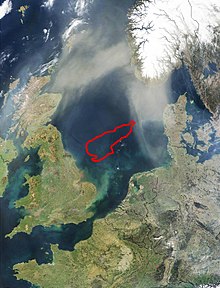Doggerbank Disease
The Doggerbank's disease , also known as Doggerbank itch (engl. Dogger bank-itch ) is a skin disease , which is found exclusively in North Sea fishermen, the centrally located in the North Sea lying Doggerbank with bottom trawls to fish.
cause and effect
In the Doggerbank disease is an allergic reaction to the (2-hydroxyethyl) -dimethylsulfoxonium - cation , which by bryozoans (Bryozoa) of the type gelatinosum Alcyonidium is produced. These bryozoa, which only occur in the affected marine region, live in colonies on the sea floor and are carried away by the trawls. The fishermen come into contact with the animals involuntarily, and the skin becomes sensitized to the ion in question within a few months to several years .
The sulfoxonium ion is present in very low concentrations, only 5 ppm of the dry matter of the bogfish represent corresponding ions. After contact there is a coupling with the proteins of the skin or blood serum and thus an antigen formation , which triggers the allergic reaction . The symptoms are reddening of the skin , swelling and blisters .
literature
- Dietrich Mebs: Gifttiere - A manual for biologists, toxicologists, doctors and pharmacists. Wissenschaftliche Verlagsgesellschaft mbH, Stuttgart 1992; Page 126. ISBN 3-8047-1219-3
- Joergen S. Carle, Carsten Christophersen: Dogger Bank itch. The allergen is (2-hydroxyethyl) dimethylsulfoxonium ion. Journal of the American Chemical Society 1980 , 102 , 5107-5108

